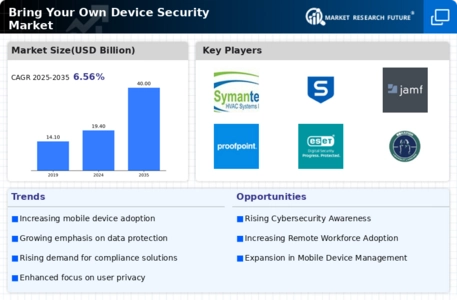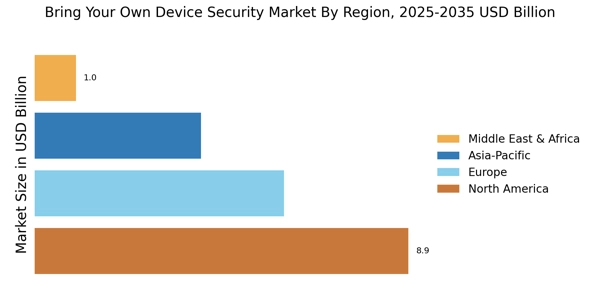Rise in Remote Work Culture
The rise in remote work culture has catalyzed the demand for Bring Your Own Device Security Market solutions. As organizations increasingly adopt flexible work arrangements, employees utilize personal devices to access corporate resources. This trend necessitates robust security measures to protect sensitive data from potential breaches. According to recent data, approximately 70% of employees now work remotely at least part-time, highlighting the urgency for effective security protocols. The Bring Your Own Device Security Market is thus witnessing a surge in demand for solutions that can secure personal devices while maintaining user privacy. Companies are investing in advanced security technologies, such as mobile device management and encryption, to mitigate risks associated with remote access. This shift not only enhances security but also fosters employee productivity, indicating a symbiotic relationship between remote work and security solutions.
Increasing Cybersecurity Threats
The escalating frequency and sophistication of cyber threats are driving the growth of the Bring Your Own Device Security Market. Organizations face a myriad of risks, including malware, phishing attacks, and data breaches, which can compromise sensitive information accessed through personal devices. Recent statistics indicate that cyberattacks have increased by over 30% in the past year, underscoring the urgent need for enhanced security measures. As a result, businesses are compelled to adopt comprehensive security frameworks that encompass personal devices used by employees. The Bring Your Own Device Security Market is responding to this challenge by offering innovative solutions that integrate threat detection, response capabilities, and user authentication. This proactive approach not only safeguards corporate data but also builds trust among stakeholders, as organizations demonstrate their commitment to cybersecurity.
Growing Awareness of Data Privacy
The growing awareness of data privacy among consumers and organizations is a pivotal driver for the Bring Your Own Device Security Market. As individuals become more conscious of their personal data and its potential misuse, there is a heightened demand for security solutions that protect sensitive information accessed through personal devices. Surveys indicate that over 60% of consumers express concerns about data privacy, prompting organizations to prioritize security measures. This trend is influencing corporate policies, as businesses recognize the need to safeguard customer data to maintain trust and loyalty. Consequently, the Bring Your Own Device Security Market is experiencing increased investment in solutions that enhance data protection, such as encryption and secure access protocols. This shift not only addresses consumer concerns but also aligns with broader societal expectations regarding data privacy.
Regulatory Compliance Requirements
Regulatory compliance is a significant driver for the Bring Your Own Device Security Market, as organizations must adhere to various data protection laws and industry standards. Regulations such as the General Data Protection Regulation (GDPR) and the Health Insurance Portability and Accountability Act (HIPAA) impose stringent requirements on how organizations manage and protect sensitive data. Non-compliance can result in hefty fines and reputational damage, prompting businesses to invest in security solutions that ensure compliance. The Bring Your Own Device Security Market is witnessing a surge in demand for solutions that facilitate compliance by providing data encryption, access controls, and audit trails. As organizations navigate the complexities of regulatory landscapes, the need for robust security measures becomes paramount, driving the adoption of comprehensive Bring Your Own Device security strategies.
Technological Advancements in Security Solutions
Technological advancements are significantly influencing the Bring Your Own Device Security Market, as innovations in security solutions enhance the ability to protect personal devices. Emerging technologies such as artificial intelligence, machine learning, and blockchain are being integrated into security frameworks, providing organizations with sophisticated tools to combat cyber threats. For instance, AI-driven analytics can identify unusual patterns of behavior, enabling proactive threat detection. The market for these advanced security solutions is projected to grow substantially, with estimates suggesting a compound annual growth rate of over 15% in the coming years. This growth reflects the increasing recognition of the importance of securing personal devices within corporate environments. As organizations seek to leverage these technologies, the Bring Your Own Device Security Market is poised for continued expansion, driven by the need for innovative security measures.


















Leave a Comment